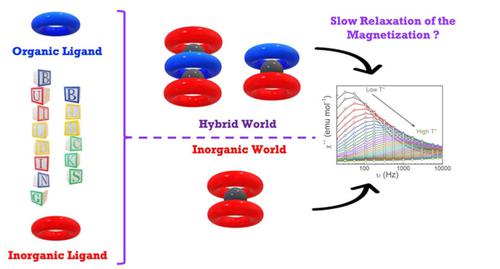当前位置:
X-MOL 学术
›
Eur. J. Inorg. Chem.
›
论文详情
Our official English website, www.x-mol.net, welcomes your
feedback! (Note: you will need to create a separate account there.)
Role of the Templating Heteroatom on Both Structural and Magnetic Properties of POM-Based SIM Lanthanoid Complexes
European Journal of Inorganic Chemistry ( IF 2.2 ) Pub Date : 2021-09-14 , DOI: 10.1002/ejic.202100670 Walter Cañon-Mancisidor 1 , Olivier Cador 2 , Patricio Hermosilla-Ibáñez 3 , Diego Venega-Yazigi 4 , Boris Le Guennic 2 , Fabrice Pointillart 5 , Gabriela Paredes-Castillo 4
European Journal of Inorganic Chemistry ( IF 2.2 ) Pub Date : 2021-09-14 , DOI: 10.1002/ejic.202100670 Walter Cañon-Mancisidor 1 , Olivier Cador 2 , Patricio Hermosilla-Ibáñez 3 , Diego Venega-Yazigi 4 , Boris Le Guennic 2 , Fabrice Pointillart 5 , Gabriela Paredes-Castillo 4
Affiliation

|
The plasticity of the coordination chemistry of Lanthanoid ions (LnIII) has allow the design of novel coordination compounds with slow relaxation of the magnetization since the first Single Ion Magnet (SIMs) was reported by Ishikawa, who used the phthalocyaninate ligand to make a “sandwich type” complex. The coordination chemistry has allowed the possibility to design different types of molecular complexes with SIMs behaviour based on organic ligands. There is also SIMs based on inorganic ligands, using different types of lacunary polyoxometalates (LPOM) like, [XW11O39]n−. The combination of both types of ligands can produce hybrid inorganic-organic LnIII complexes with SIM behaviour. This is an attractive approach since these hybrid materials could benefit from the combination of the ease of functionalization of the organic ligands with the robustness of the inorganic moieties. There are reports that a hybrid mononuclear DyIII complex could improve the relaxation dynamics when it is compared to the inorganic analogues. Thus, in this review we present a study and comparison on the improvement that inorganic and organic ligands can cause to the geometry of the metal centres of fully inorganic and hybrid (mononuclear and dinuclear) lanthanoid complexes (for DyIII, ErIII and YbIII). Moreover, we will discuss which of these changes can modify the magnetic properties of the Lanthanoid Complexes.
中文翻译:

模板杂原子对基于 POM 的 SIM 镧系元素配合物的结构和磁性能的作用
自从 Ishikawa 报道了第一个单离子磁铁 (SIM) 以来,镧系元素离子 (Ln III )配位化学的可塑性允许设计具有缓慢磁化弛豫的新型配位化合物,他使用酞菁配体制造“三明治型”复合体。配位化学使设计具有基于有机配体的 SIM 行为的不同类型分子复合物成为可能。还有基于无机配体的 SIM,使用不同类型的缺位多金属氧酸盐 (LPOM),如 [XW 11 O 39 ] n-。两种配体的结合可以产生杂化无机-有机Ln III与 SIM 行为的复合物。这是一种有吸引力的方法,因为这些混合材料可以受益于有机配体的易于官能化与无机部分的稳健性的结合。有报道称,与无机类似物相比,混合单核 Dy III 配合物可以改善弛豫动力学。因此,在这篇综述中,我们对无机和有机配体对完全无机和杂化(单核和双核)镧系元素配合物(Dy III、Er III和 Yb III)的金属中心几何形状的改进进行了研究和比较。)。此外,我们将讨论这些变化中的哪些可以改变镧系元素配合物的磁性。
更新日期:2021-09-28
中文翻译:

模板杂原子对基于 POM 的 SIM 镧系元素配合物的结构和磁性能的作用
自从 Ishikawa 报道了第一个单离子磁铁 (SIM) 以来,镧系元素离子 (Ln III )配位化学的可塑性允许设计具有缓慢磁化弛豫的新型配位化合物,他使用酞菁配体制造“三明治型”复合体。配位化学使设计具有基于有机配体的 SIM 行为的不同类型分子复合物成为可能。还有基于无机配体的 SIM,使用不同类型的缺位多金属氧酸盐 (LPOM),如 [XW 11 O 39 ] n-。两种配体的结合可以产生杂化无机-有机Ln III与 SIM 行为的复合物。这是一种有吸引力的方法,因为这些混合材料可以受益于有机配体的易于官能化与无机部分的稳健性的结合。有报道称,与无机类似物相比,混合单核 Dy III 配合物可以改善弛豫动力学。因此,在这篇综述中,我们对无机和有机配体对完全无机和杂化(单核和双核)镧系元素配合物(Dy III、Er III和 Yb III)的金属中心几何形状的改进进行了研究和比较。)。此外,我们将讨论这些变化中的哪些可以改变镧系元素配合物的磁性。











































 京公网安备 11010802027423号
京公网安备 11010802027423号